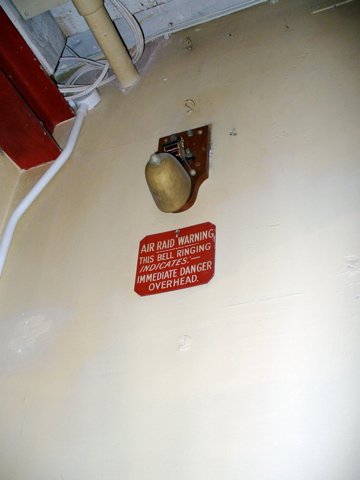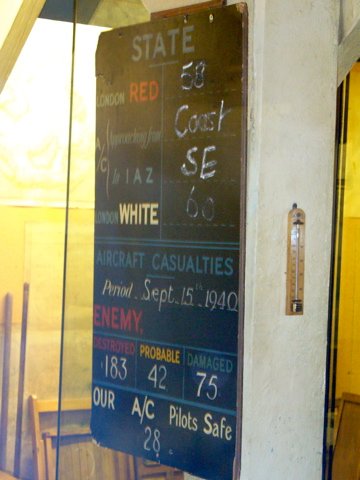
One week I'm looking out over London's skyline from the top of St Paul's, the next I'm exploring underneath its streets, at the Churchill Museum and Cabinet War Rooms. But this post is only about the latter, as no photography is allowed in the Museum. That's OK: while the museum was most interesting and very well done (and seemingly a magnet for American tourists), the Cabinet War Rooms -- the underground bunker complex from where, in large part, the British war effort was directed during the Second World War -- were why I was there. Everything was closed down and mothballed after V-J day, and at least some areas remained as they were during the war, until it was opened up again in the early 1980s; others have been restored more heavily (or turned into cafes!)
Above is the entrance, in King Charles Street, just off Horse Guards Road (and just a block away from Downing Street). It's next to HM Treasury, though during the war the building seems to have been the Office of Works. On the one hand, the sandbagged entrance with machine gun slit is nicely evocative of a wartime sentry pillbox. On the other, it's all fake: the real wartime entrance to the bunker was through adjacent government buildings. Plus several of the "sandbags" have been torn by some malcontent and it's looking a bit tatty!

As anyone who has ever had to work in a windowless office can imagine, it must have been disorienting to work, eat and sleep underground (as at least some people did, though Churchill himself only spent a few nights here). It would be very easy to become disconnected from the world above. This weather report would have allowed people to at least imagine what it was like outside, and if they were actually going out, to know whether to put on a mac and wellies first!

'Air raid warning. This bell ringing indicates:- immediate danger overhead.' Though of course part of the reason to put the war rooms underground was because of the risk of bombing, the complex is not actually all that deep. A direct hit could have caused much damage. So a much deeper set of war rooms, code-named PADDOCK, was built (at great expense) in the north of London at Dollis Hill, but Churchill never liked it and it was never used much.

This table helpfully explains the meaning of the various alarms. Note the last two sections in particular, for gas and for ground attack. Luckily these didn't see much use during the war. It's interesting that the possibility of attack from inside the building is mentioned. I wonder what was envisaged here -- infiltration? fifth columnists? treason? mechanical moles? Any or all of the above, I suppose.

The Chiefs of Staff conference room. The map on the left-hand wall, showing Britain and its surrounding seas, has been defaced with a graffito of Hitler giving a sieg heil in the middle of the North Atlantic. I'd like to think that one of the service chiefs was responsible for this.

Same room. I think at some point somebody said, hey, that wall's bare! Let's put up even more maps, just so nobody can possibly fail to understand that they're in a war room.

Speaking of maps, I'm not sure which room this was in -- it was just after a little tunnel and before the Map Room proper -- it shows the Allied occupation zones in Germany at the end of the war (although the main US zone was in the south, they also had the enclave on the North Sea, around the port of Bremerhaven, through which they brought their supplies during the Cold War).

This is from the same room -- it's probably a bit hard to read, but these are tabulated statistics relating to the German flying bomb attacks on southern England between 16 June and 6 September 1944. So, for example, for 19 June, the day with the highest number of casualties, the table reads: 151 flying bombs launched, 128 crossed the coast, 51 over London; 46 destroyed by fighters, 6 by anti-aircraft; 305 fatalities, 1307 serious injuries, and 697 slight injuries.

This is from the Map Room: a tally board of the day's action in the air over London on 15 September 1940, what was later called Battle of Britain Day. The bottom half is easy to interpret. It shows the casualties for both sides (though as we know now, the Luftwaffe lost only 60 aircraft that day, not the 183 -- and 42 probables -- claimed here). The top part is a bit trickier. A/C is aircraft, so we have "Aircraft approaching from coast", which doesn't seem very useful. I think IAZ is the azimuthal angle, that is the direction the raiders are coming from, in this case the south-east (though to be pedantic, the azimuthal angle should read 135° instead of the compass direction). I'd guess that "London red" and "London white" refer to the number of German and British aircraft engaged over (or approaching) London, respectively. Red for the Germans because the word "Enemy" in the casualties section is red, but if so, then 58 seems like an oddly precise estimate. So perhaps it's the other way around, or it means something else altogether.
I was puzzled as to why there was anything to do with the Battle of Britain in here at all, since the Map Room is apparently very close in appearance to the way it was at the end of the war (because it was just boarded up on the day after V-J Day with all the maps and pins still in place, and left to moulder for a few decades). But it seems that a photo exists of the Map Room from late in the war showing just such a tally board, with the figures for 15 September 1940 permanently painted on it. So even before the war ended, that day was being seen as a turning point. More importantly, my scepticism over the authenticity of the restoration was misplaced; score one for the IWM :)
![]() This work is licensed under a Creative Commons Attribution-NonCommercial-NoDerivatives 4.0 International License.
Permissions beyond the scope of this license may be available at http://airminded.org/copyright/.
This work is licensed under a Creative Commons Attribution-NonCommercial-NoDerivatives 4.0 International License.
Permissions beyond the scope of this license may be available at http://airminded.org/copyright/.

